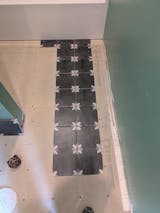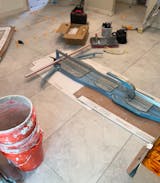What is Mastic?
Mastic is an organic glue made from the sticky resin of the mastic tree. It’s available as a thin-liquid, thick glue, or a sticky paste. Liquid Nails® would be a notable example of the thin-liquid form where it comes in a caulking tube and squeezed out along a wall or joists to hold load-bearing walls and ceilings in place. It’s also used as a temporary hold for fixtures so they can easily be screwed into place by one person.
Mastic as a tile adhesive has a number of drawbacks, since it’s organic, it can harbor mold in high-moisture areas, it also will re-liquefy when submerged in water and lose it’s adhesive strength. Some manufacturers are promoting their tile adhesive as water-resistant and safe when subjected to limited moisture exposure, they further claim that it can be safely used to tile the walls of tub surrounds. This is where we personally have questions. It’s not that we take issue with the specific language used by the manufacturers, we just have an issue with what we perceive as a disregard for reality when making their claim.
We feel that mastic tile adhesives are a great time-saver when laying tile, but knowing the laws of physics and nature, we feel that mastic adhesive is not appropriate for use anywhere where moisture is present. Although the manufacturer is correct in stating that tile will hold up to limited water exposure, who’d want to choose mastic over thinset when using it in area where limited water exposure could possibly end up being “more than limited”.
Let’s say you tiled your shower using mastic and you shower in it daily. Everything will work out fine if your tiles remain properly sealed and no cracks form in the grout, and your shower-head performs perfectly. But what will happen if you’ve formed a tiny little crack in a tiny little area of your properly sealed tile where moisture not only penetrates, but has a tendency to wick and spread? Will your mastic adhesive hold up? What if the mastic does hold up when a little bit of moisture penetrates? What about the organic property of mastic? All that’s needed for mold growth is moisture and an organic food source. Mastic is food for mold! Another drawback is that mastic doesn’t provide much structural support and cannot be used to build up minor “off of level” imperfections in a floor. You’ll end up with more “tile lippage”, in the end this tile lippage will have an impact on the overall aesthetics of your tile project.
Although there are drawbacks with mastic, there are advantages. Mastic has superior holding strength, easier to apply, and sets quickly. When used to tile walls it’s strength allows you to set tile, and if you’re good with eyeballing, you can set tile without the use of spacers. If you attempt to set wall tiles using thinset without spacers, you’ll end up with a bunch of tiles that have slid into each other before the thinset has had time to set, resulting in a giant mess.
With that said, ALWAY read the manufacturer's instructions and follow specifications and guidelines!
What is Thin-Set?
Thin-set mortar is like Portland Cement, only thinner. It’s a mixture of cement, finely graded sand, and a water-retention compound that allows the cement to properly hydrate. You’ll find thin-set sold with the words “thin set cement”, “thin-set mortar”, “dryset mortar”, and “drybond mortar”. Whatever name you find it as, we’re talking about the same thing. Thinset is designed to adhere well in a thin layer that’s typically not greater than 3/16″ thick. Thinset also provides structural support so that very minor adjustments in height can be made.
There’s also a medium bed (also known as LFT or LHT) thin set mortar which is a variation that’s used for slightly larger applications. This is used with large, heavy or thick tiles. Then there’s yet another variation of thin set for thick-bed installations. Thick bed installations generally are based on the traditional method of packing a mortar bed of a surface before installing the tile. The tile can be adhered to the mortar bed either while the mortar bed is beginning to dry or after the mortar bed has cured.
The advantages of thin-set is that it can be used in areas where there are high amounts of moisture present. Although thin-set is not waterproof, it is isn’t water soluble. When moisture is present, it will not return to a liquefied state as mastic would. Another advantage is that it’s inorganic and thus is not a food source for mold growth.
Now on with the battle of Mastic vs. Thinset!
- Shower floors – Thinset
- Shower walls – Thinset
- Bathroom floors – Thinset
- Bathroom walls – Thinset
- Kitchen floors – Thinset
- Kitchen walls – Mastic
- Kitchen countertops – Thinset
- Kitchen backsplashes – Mastic
- Other floors – Thinset
- Other walls – Mastic (where moisture is not present)
Keeping in mind of course, the material being installed. Mastic can only be used for ceramic and porcelain tiles usually not larger than 13"x13".
What size trowel do I use?
For Mastic
Follow the manufacturer’s directions on the packaging.
For Thinset
Visit our popular blog: What Size Trowel Do I Use? for an explanation of which size trowel to use





Comments
Leave a comment